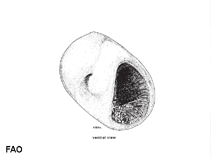Polinices peselephanti (Link, 1807)
Elephant's-foot moon snail
Classification / Names Common names | Synonyms | CoL | ITIS | WoRMS
| Littorinimorpha | Naticidae
Environment: milieu / climate zone / depth range / distribution range Ecología
; rango de profundidad 0 - 10 m (Ref. 349). Tropical
Distribución Países | Áreas FAO | Ecosistemas | Ocurrencias, apariciones | Introducciones
Indo-Pacific: from South Africa and the Red Sea, to Papua New Guinea; north to the Philippines and south to New South Wales.
Length at first maturity / Tamaño / Peso / Age
Maturity: Lm ? range ? - ? cm Max length : 5.0 cm ShH macho / no sexado; (Ref. 349); common length : 3.5 cm SHL macho / no sexado; (Ref. 349)
Occurs at the low tide mark (Ref. 349).
Life cycle and mating behavior Madurez | Reproducción | Puesta | Huevos | Fecundidad | Larva
Members of the order Neotaenioglossa are mostly gonochoric and broadcast spawners. Life cycle: Embryos develop into planktonic trocophore larvae and later into juvenile veligers before becoming fully grown adults.
Main reference
Referencias | Coordinador | Colaboradores
Poutiers, J.M. 1998. (Ref. 349)
IUCN Red List Status (Ref. 130435)
CITES status (Ref. 108899)
Not Evaluated
CMS (Ref. 116361)
Not Evaluated
Threat to humans
Harmless
Human uses
Pesquerías: comercial
| FishSource |
Herramientas
Más información
Países
Áreas FAO
Ecosistemas
Ocurrencias, apariciones
Introducciones
Stocks
Ecología
Dieta
componentes alimenticios
Áreas FAO
Ecosistemas
Ocurrencias, apariciones
Introducciones
Stocks
Ecología
Dieta
componentes alimenticios
Fuentes de Internet
BHL | BOLD Systems | CISTI | DiscoverLife | FAO(Publication : search) | Fishipedia | GenBank (genome, nucleotide) | GloBI | Gomexsi | Google Books | Google Scholar | Google | PubMed | Árbol de la vida | Wikipedia (Go, búsqueda) | Expediente Zoológico
Estimates based on models
Preferred temperature
(Ref. 115969): 24.9 - 29.3, mean 28.5 (based on 3346 cells).
Price category
(Ref. 80766):
Unknown.



